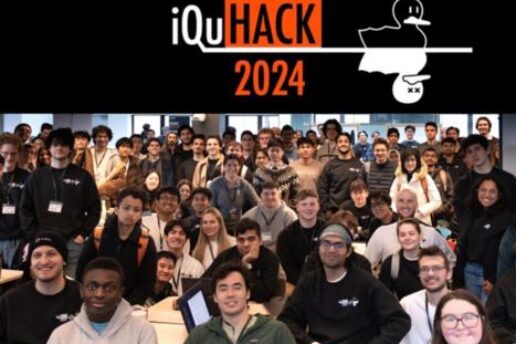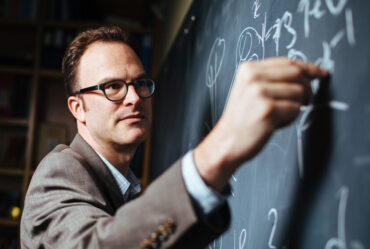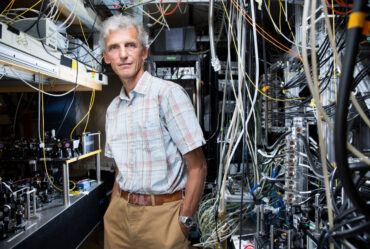
Unlocking the quantum future
At the MIT Quantum Hackathon, a community tackles quantum computing challenges.
Quantum computing is the next frontier for faster and more powerful computing technologies. It has the potential to better optimize routes for shipping and delivery, speed up battery development for electric vehicles, and more accurately predict trends in financial markets. But to unlock the quantum future, scientists and engineers need to solve outstanding technical challenges while continuing to explore new applications.
One place where they’re working towards this future is the MIT Interdisciplinary Quantum Hackathon, or iQuHACK for short (pronounced “i-quack,” like a duck). Each year, a community of quhackers (quantum hackers) gathers at iQuHACK to work on quantum computing projects using real quantum computers and simulators. This year, the hackathon was held both in-person at MIT and online over three days in February.
Quhackers worked in teams to advance the capability of quantum computers and to investigate promising applications. Collectively, they tackled a wide range of projects, such as running a quantum-powered dating service, building an organ donor matching app, and breaking into quantum vaults. While working, quhackers could consult with scientists and engineers in attendance from sponsoring companies. Many sponsors also received feedback and ideas from quhackers to help improve their quantum platforms.
But organizing iQuHACK 2024 was no easy feat. Co-chairs Alessandro Buzzi and Daniela Zaidenberg led a committee of nine members to hold the largest iQuHACK yet. “It wouldn’t have been possible without them,” Buzzi said. The hackathon hosted 260 in-person quhackers and 1,000 remote quhackers, representing 77 countries in total. More than 20 scientists and engineers from sponsoring companies also attended in person as mentors for quhackers.
Each team of quhackers tackled one of 10 challenges posed by the hackathon’s eight major sponsoring companies. Some challenges asked quhackers to improve computing performance, such as by making quantum algorithms faster and more accurate. Other challenges asked quhackers to explore applying quantum computing to other fields, such as finance and machine learning. The sponsors worked with the iQuHACK committee to craft creative challenges with industry relevance and societal impact. “We wanted people to be able to address an interesting challenge [that has] applications in the real world,” says Zaidenberg.
One team of quhackers looked for potential quantum applications and found one close to home: dating. A team member, Liam Kronman, had previously built dating apps but disliked that matching algorithms for normal classical computers “require [an overly] strict setup.” With these classical algorithms, people must be split into two groups — for example, men and women — and matches can only be made between these groups. But with quantum computers, matching algorithms are more flexible and can consider all possible combinations, enabling the inclusion of multiple genders and gender preferences.
Kronman and his team members leveraged these quantum algorithms to build a quantum-powered dating platform called MITqute (pronounced “meet cute”). To date, the platform has matched at least 240 people from the iQuHACK and MIT undergrad communities. In a follow-up survey, 13 out of 41 respondents reported having talked with their match, with at least two pairs setting up dates. “I really lucked out with this one,” one respondent wrote.
Another team of quhackers also based their project on quantum matching algorithms but instead leveraged the algorithms’ power for medical care. The team built a mobile app that matches organ donors to patients, earning them the hackathon’s top social impact award.
But they almost didn’t go through with their project. “At one point, we were considering scrapping the whole thing because we thought we couldn’t implement the algorithm,” says Alma Alex, one of the developers. After talking with their hackathon mentor for advice, though, the team learned that another group was working on a similar type of project — incidentally, the MITqute team. Knowing that others were tackling the same problem inspired them to persevere.
A sense of community also helped to motivate other quhackers. For one of the challenges, quhackers were tasked with hacking into 13 virtual quantum vaults. Teams could see each other’s progress on each vault in real time on a leaderboard, and this knowledge informed their strategies. When the first vault was successfully hacked by a team, progress from many other teams spiked on that vault and slowed down on others, says Daiwei Zhu, a quantum applications scientist at IonQ and one of the challenge’s two architects.
The vault challenge may appear to be just a fun series of puzzles, but the solutions can be used in quantum computers to improve their efficiency and accuracy. To hack into a vault, quhackers had to first figure out its secret key — an unknown quantum state — using a maximum of 20 probing tests. Then, they had to change the key’s state to a target state. These types of characterizations and modifications of quantum states are “fundamental” for quantum computers to work, says Jason Iaconis, a quantum applications engineer at IonQ and the challenge’s other architect.
But the best way to characterize and modify states is not yet clear. “Some of the [vaults] we [didn’t] even know how to solve ourselves,” Zhu says. At the end of the hackathon, six vaults had at least one team mostly hack into them. (In the quantum world where gray areas exist, it’s possible to partly hack into a vault.)
The community of scientists and engineers formed at iQuHACK persists beyond the weekend, and many members continue to grow the community outside the hackathon. Inspired quhackers have gone on to start their own quantum computing clubs at their universities. A few years ago, a group of undergraduate quhackers from different universities formed a Quantum Coalition that now hosts their own quantum hackathons. “It’s crazy to see how the hackathon itself spreads and how many people start their own initiatives,” co-chair Zaidenberg says.
The three-day hackathon opened with a keynote from MIT Professor Will Oliver, which included an overview of basic quantum computing concepts, current challenges, and computing technologies. Following that were industry talks and a panel of six industry and academic quantum experts, including MIT Professor Peter Shor, who is known for developing one of the most famous quantum algorithms. The panelists discussed current challenges, future applications, the importance of collaboration, and the need for ample testing.
Later, sponsors held technical workshops where quhackers could learn the nitty-gritty details of programming on specific quantum platforms. Day one closed out with a talk by research scientist Xinghui Yin on the role of quantum technology at LIGO, the Laser Interferometer Gravitational-Wave Observatory that first detected gravitational waves. The next day, the hackathon’s challenges were announced at 10 a.m., and hacking kicked off at the MIT InnovationHQ. In the afternoon, attendees could also tour MIT quantum computing labs.
Hacking continued overnight at the MIT Museum and ended back at MIT iHQ at 10 a.m. on the final day. iQuhackers then presented their projects to panels of judges. Afterward, industry speakers gave lightning talks about each of their company’s latest quantum technologies and future directions. The hackathon ended with a closing ceremony, where sponsors announced the awards for each of the 10 challenges.
The hackathon was captured in a three-part video by Albert Figurt, a resident artist at MIT. Figurt shot and edited the footage in parallel with the hackathon. Each part represented one day of the hackathon and was released on the subsequent day.
Throughout the weekend, quhackers and sponsors consistently praised the hackathon’s execution and atmosphere. “That was amazing … never felt so much better, one of the best hackathons I did from over 30 hackathons I attended,” Abdullah Kazi, a quhacker, wrote on the iQuHACK Slack.
Ultimately, “[we wanted to] help people to meet each other,” co-chair Buzzi says. “The impact [of iQuHACK] is scientific in some way, but it’s very human at the most important level.”


